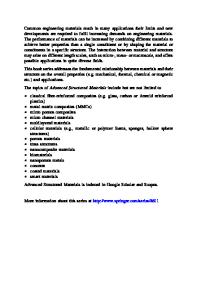A Theoretical Basis for Biomimetics
- PDF / 403,824 Bytes
- 15 Pages / 612 x 792 pts (letter) Page_size
- 84 Downloads / 1,453 Views
0898-L14-01.1
A Theoretical Basis for Biomimetics Julian F.V. Vincent, Olga Bogatyreva, Nikolaj Bogatyrev, Anja-Karina Pahl and Adrian Bowyer Centre for Biomimetic and Natural Technologies, Department of Mechanical Engineering, The University, Bath, BA2 7AY, UK ABSTRACT The system of TRIZ invented by Genrich Altshuller provides a useful means of cataloguing effects and functions across disciplines. Altshuller distinguished 40 Inventive Principles which represent all engineering; we list them with biological examples to illustrate the use of functional analogy in forging the (biomimetic) bridge between biology and engineering. We have further categorised the Inventive Principles into six major operational fields: those where the problem is resolved by changing the energy input, the material, the structure, the space, the time, or the information. These data have been gleaned from TRIZ [1] databases (for technology) and our own research (in biology). We have arranged the effects from which these solutions are derived according to the size at which they occur (from nm to km) and the approximate level of their hierarchy, and in doing so we have noted that in technology most problems (up to 60% at the nmmm level) are solved by the manipulation of energy, more especially at the lower end of the size range. In biology, similar problems are solved by manipulating space and, at larger sizes, information; the manipulation of energy as a parameter is constant and very low (about 5%) across the entire size range. This suggests that biology achieves its effects (i.e. life) by the spatial (re)-organisation of a few materials in which information is embedded as part of their synthesis. Perhaps man should adopt this approach in solving technical problems, using available materials to form structured hybrids, rather than inventing and developing a new material each time novel properties are desired. INTRODUCTION The nature and organisation of biology and engineering are very different: biology develops as a result of evolution, is descriptive and creates classifications, whereas engineering is a result of decision-making, is prescriptive and creates laws, rules and regularities. If one wishes to compare them, the classificatory basis should include all knowledge, be as close to reality as possible and should have clear rules. Types of classification can be hierarchical (e.g. phylogenetic), parametric (e.g. cladistic, or like the Periodic Table) or combinatorial. Approximately 50 years ago in Russia a particularly successful problem-solving system began to be developed. It was named TRIZ, the acronym of Teorija Reshenija Izobretatel'skih Zadach (loosely translated as "Theory of Inventive Problem Solving"). TRIZ is well known for its successful transfer of various inventions and solutions from one field of engineering to another. Since the main thrust of biomimetics is also to transfer functions, mechanisms and principles from one field to another, TRIZ seems the ideal starting point. One of the main tools of TRIZ – the resolution of
Data Loading...











